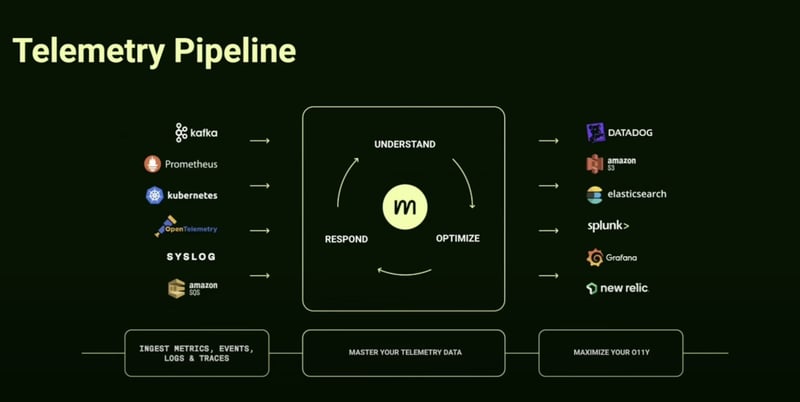
Mezmo X CENSUS
How Mezmo unlocks the power of Salesforce with Census
Industry: SaaS, Product-Led Growth
Headquarters: San Francisco, CA
Company type: B2B
Team: Sales and RevOps
Use cases: Product Metrics in CRM
Featured integrations: Salesforce, Snowflake, Customer.io, Google Sheets, HubSpot, Outreach, Pendo, Zendesk
Mezmo provides centralized log management solutions for small to enterprise-level clients. Jeff Ronaldi, sales and marketing operations manager, works alongside several different teams including product managers, revenue operations, sales and marketing teams, and the data analyst team, to provide sales insights so that they can “know what’s actually happening” in their business.
In order to provide their customers a great experience, Mezmo uses Census to surface all of their data insights in Salesforce and their other business tools.
"I’ll be able to simplify our process and provide everyone in sales & marketing with a better view of each customer, and I’ll be using Census to do it."
Jeff Ronaldi, Sales & Marketing Operations
The Challenge
When Jeff started at Mezmo, he knew there was a problem getting information appropriately logged into Salesforce. “I was being asked pretty simple questions like, ‘How many customers are paying us?’ or ‘How many people signed up for a trial last week?’ ‘How many of those people converted?’ and we didn’t have a standard way to answer those questions,” says Jeff.
At one point, Jeff’s CMO asked him to begin monitoring the number of trial signups they had, and it was this simple question that started Jeff on his journey toward Census.
The Beginning
Tasked with hunting down trial signups, Jeff began manually checking and pulling information from HubSpot and other marketing automation tools to count the trial signups. About a month later, he started comparing his invoice data in Stripe to the data in Salesforce, which is when he began noticing some discrepancies.
“I remember it was Halloween when I first noticed,” says Jeff. “We were using a manual process to correlate information when I realized the trial numbers I saw in one place didn’t match with what I saw in the other. We later found out that half the people who were signing up for our product weren’t getting into our system at all because there was something broken.”
For Jeff and his team, this meant that hundreds of new leads were signing up and immediately falling through the cracks. They knew that if these problems were happening in trial accounts, that these issues would have large trickle-down effects.
The Catalyst
As an interim fix, Jeff set up some pretty extensive band-aids. One engineer would go into MongoDB and export information on a weekly basis, and Jeff would take the export, reformat it manually in a sheet, and re-import it back into Salesforce.
After a few weeks, it became clear how unsustainable this process was going to be. Not only did the process take Jeff and his team a considerable amount of time, but it didn’t actually allow them to reach their new leads in a timely manner. Now potential clients weren’t falling off entirely, which was good, but they were being met with days of radio silence before they were able to be processed and contacted by the marketing team.
That’s when Jeff really began looking for tools to allow them to sync the information from Redshift into Salesforce.
“I was trying everything,” says Jeff. “When we got other tools, they didn’t actually solve the problem. In fact, they were just as inhibited in their analysis as I was because the information wasn’t there. That’s when we discovered Census. The use case of taking information from Redshift and pumping it directly into Salesforce was the perfect solution for what we’re looking for.”

“I was finally able to use all the functionality of Salesforce reporting, so now not only are we able to capture that other 50% of people signing up for our product trial, but we could put them through marketing automations right away.”
Jeff Ronaldi
Sales & Marketing Operations

The Solution
Syncing data to Salesforce with Census
Jeff reached out to Census about finding a solution to automate his manual work, and get Mezmo to a place where the marketing insights he was looking for could finally become readily available.
Once Jeff and his team began integrating Census into their system, it opened up a whole new world of possibilities. Gone were the days of doing a long, drawn-out process of export, formatting, and reimporting — with Census, they were able to automate the process.
Jeff began using Census’ 1-1 mapping features to connect tables from their database, to the objects in Salesforce, “With Census, as long as it hits one of our three databases, it will connect to everything else, and it is all very simple and intuitive, even for me, and I do not have a technical background, I’m a sales guy,” says Jeff.
Next, together with the sales team, Jeff began leveraging the Salesforce reports to identify which customers were growing, who the heavy users were, and implementing product scoring to help them organize and prioritize which accounts could be high-priority in the long term.
That’s When Things Really Took Off
Both the sales and marketing teams leverage these product scores to give them a more thorough understanding of where each customer is at in their customer lifecycle.
“This was only possible by joining the Salesforce table and the application production table in Redshift and using Census to pump it back in,” says Jeff. “Now we get hundreds of trial signups and it’s really helping us to know they’re all really being counted, and also to prioritize which ones we want to go after. This process has changed the way we work, and a lot of the elements we have access to now, I didn’t know were possible before Census.”
The Benefits of Using Census
These days, Jeff says “Census has really been game-changing for us in terms of being able to serve our customers,” and he’s seen that especially when it comes to his sales and marketing teams.
For example, Jeff saw a big change when Mezmo started to implement product scoring. “Right now, my product analyst is using this meta data and we’re pumping that directly back into Salesforce, and that’s mapping back to HubSpot,” says Jeff. “Which means that both the sale and marketing are using these scores, and that was only possible by joining the Salesforce tables and the production tables in Redshift and using Census to pump it back in.”
In the end, what Jeff found with Census was not only an easy solution to solve his exact issues, but a team of people who were eager to help him along the way. In fact, Jeff says that one of the biggest differentiators between Census and other vendors was the level of support that Census has been able to provide.
“The support alone has been absolutely exceptional,” says Jeff. “Having the slack channel, having the whole team be so responsive, it’s fantastic. It’s been a huge differentiator that I can always get feedback right away from the guys at Census.”
Looking Ahead
Jeff says his current project is “totally dependent on Census,” and it's been easy to find places throughout the company that can continue to evolve thanks to the functionality Census offers.
Jeff explained a little of what’s coming down the pipe for Mezmo with Census.
“Mezmo, like most apps, doesn't have that clear parent-child account hierarchy that Salesforce expects. Users just sign up for accounts, potentially multiple times and we have to make sense of it. That means calculating usage or doing billing for a single corporate entity is hard.
Census is letting me merge that information together in my warehouse and then push that into Salesforce and programmatically create the hierarchy along the way. I can make sure I'm doing the right thing and Census makes it happen in Salesforce automatically.”
By the time he’s done, Jeff hopes to consolidate all the different accounts, which are spread out throughout their system. “And when that change comes, it’ll be game-changing for us, especially on the revenue side, ” says Jeff. “I’ll be able to simplify our process and provide everyone in sales & marketing with a better view of each customer, and I’ll be using Census to do it.”
From your data warehouse to all your apps, customers, and agents.
Without code or CSVs.
Start using Census today by booking a demo with one of our experts.
















